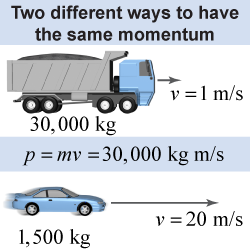|
Momentum is a property of an object in motion, whether it is a person, car, truck, or spaceship. A car traveling down the road has momentum; it requires force between the tires and road to change its velocity. A big truck traveling at the same velocity has much more momentum, because it is more difficult to change its velocity. Momentum is a quantity that describes the tendency for an object in motion to remain in motion. 
|
The momentum of a moving object is its mass multiplied by its velocity. The higher an object’s mass or velocity, the more momentum it has. A truck has more momentum than a car moving at the same speed because the truck has more mass. A car has more momentum while speeding on the highway than when moving slowly in heavy traffic. 
|
| (11.1) | | | | = | momentum (kg m/s) | | m | = | mass (kg) | | | = | velocity (m/s) |
| Momentum
|
|
Momentum is the product of mass and velocity; since velocity is a vector quantity, momentum is also a vector quantity. Momentum in one dimension can take on either positive or negative signs to indicate its direction. For example, a 10 kg ball moving at 2 m/s to the right has a momentum of +20 kg m/s, and the same ball moving to the left has a momentum of –20 kg m/s. Momentum has units of mass multiplied by speed—or kilogram meters per second (kg m/s). 
|

|
The symbol for momentum is a lowercase p or vector . Historically, momentum was identified with the persistence of an object to continue in its original speed and direction of motion. While we call it “momentum” today, Newton called it “impetus” in 1760. Impetus is derived from the Latin word petere, which means to go toward. 
|
 Objects with different masses can have the same momentum. For example, a truck moving slowly at 1 m/s can have the same momentum as a small car moving quickly at 20 m/s. Both have the same “persistence of motion” described by Newton.
Objects with different masses can have the same momentum. For example, a truck moving slowly at 1 m/s can have the same momentum as a small car moving quickly at 20 m/s. Both have the same “persistence of motion” described by Newton.
Since the velocity of an object depends on the reference frame, its momentum will also depend on the reference frame. A speeding car will have a large momentum when observed by a pedestrian but zero momentum in the driver’s reference frame. 
|
Momentum is an important quantity in physics. In the quantum world, momentum is more fundamental than either mass or velocity taken separately. Newton’s first law might be more accurately named the law of momentum, because it is really momentum that remains unchanged when the net force is zero. 
|
Which has more momentum, a 4,000 lb car traveling at 60 mph or a 30,000 kg truck traveling at 1.5 m/s?
 |
The car has more momentum. To solve, first convert all the units to SI units. The mass of the car is and the velocity of the car is The momentum of the car is and the momentum of the truck is The car therefore has more momentum. 
|

